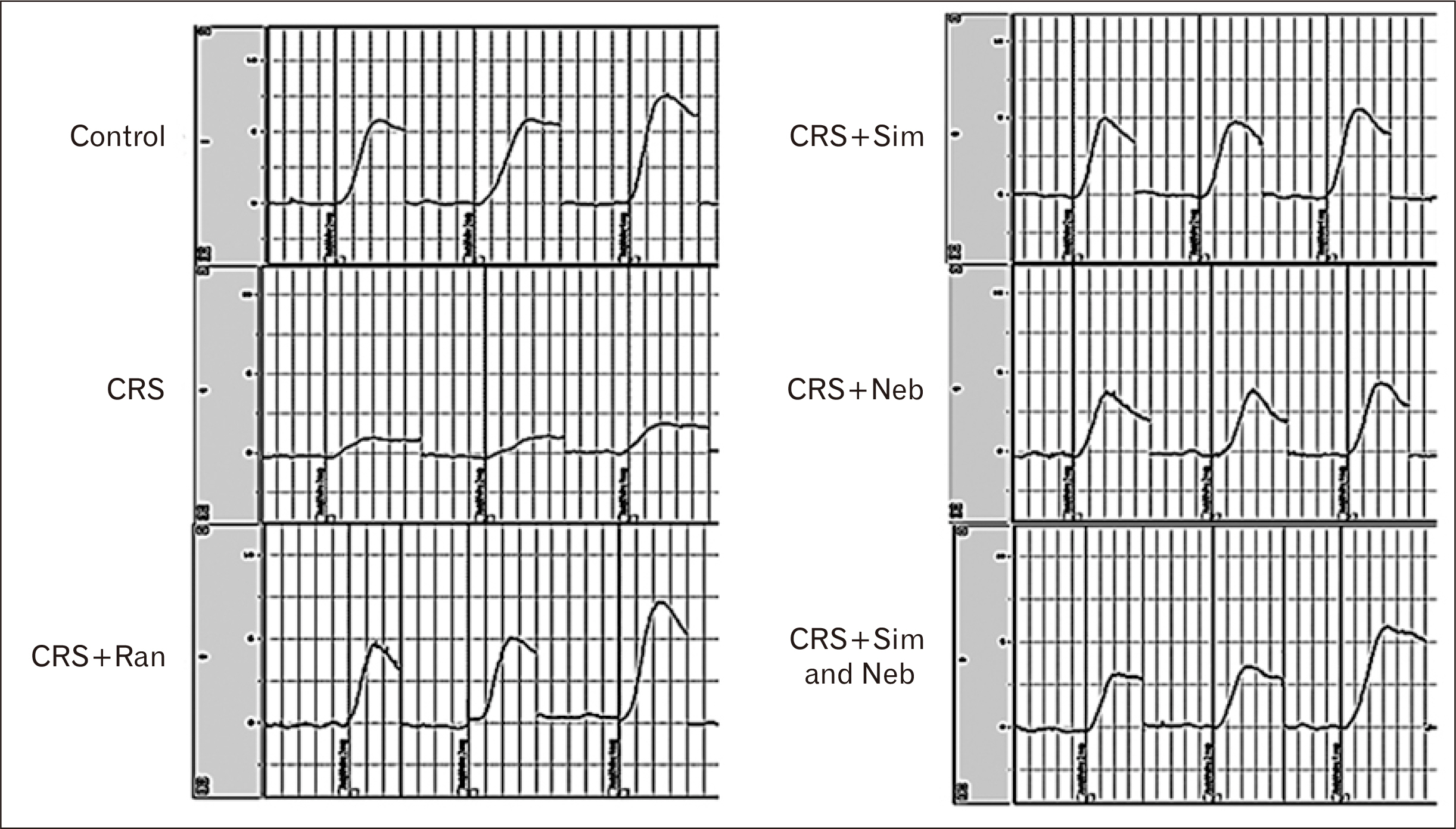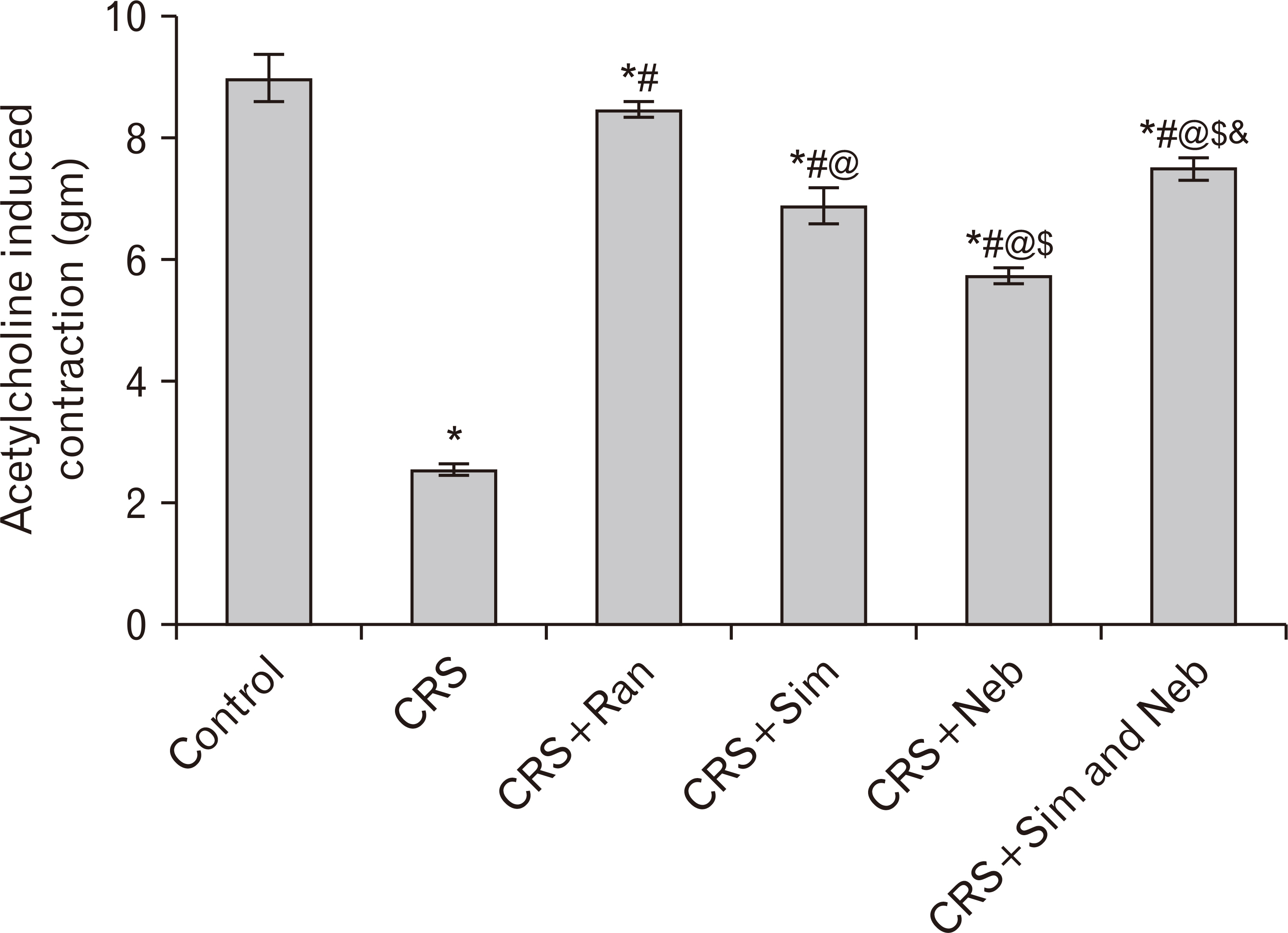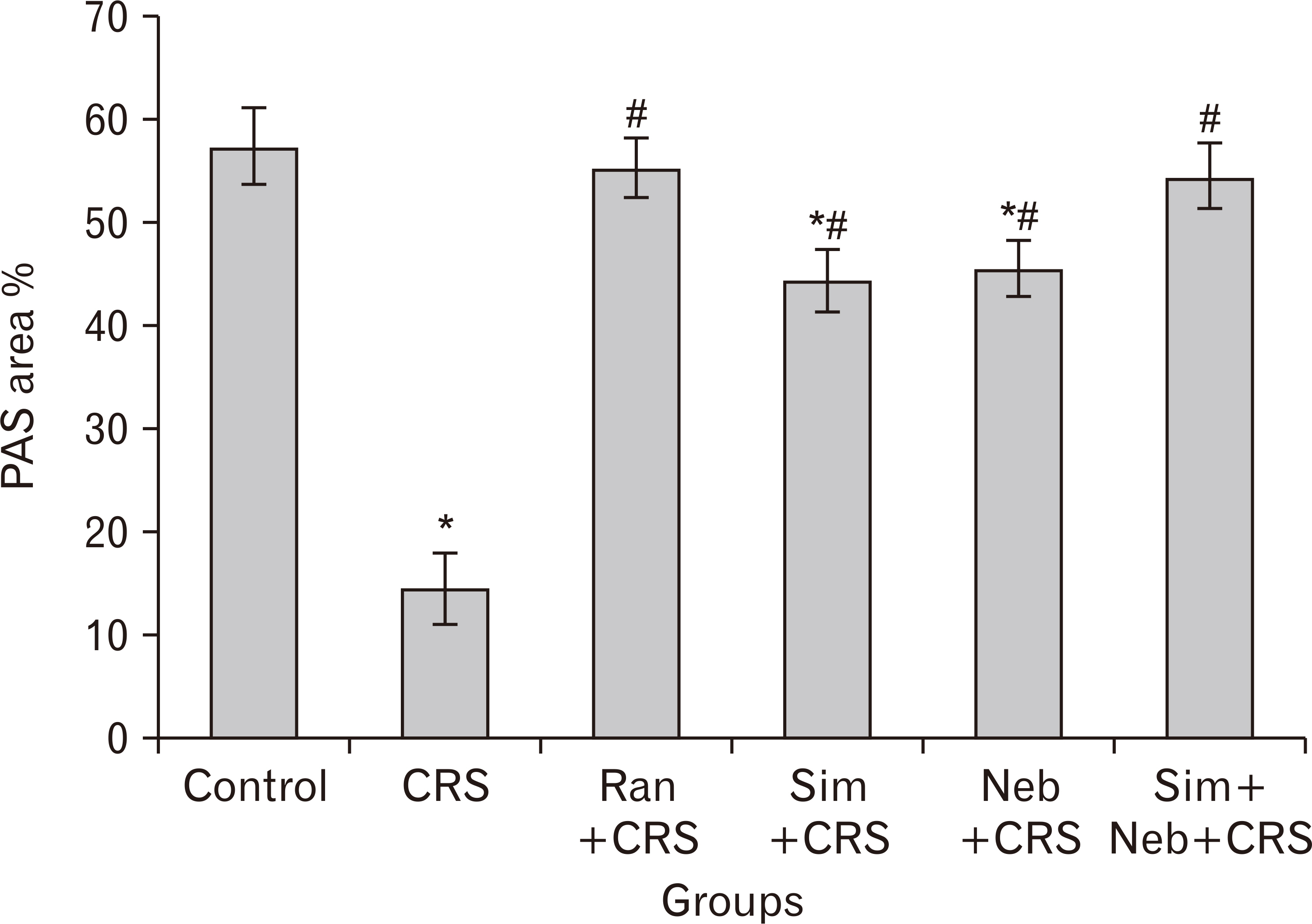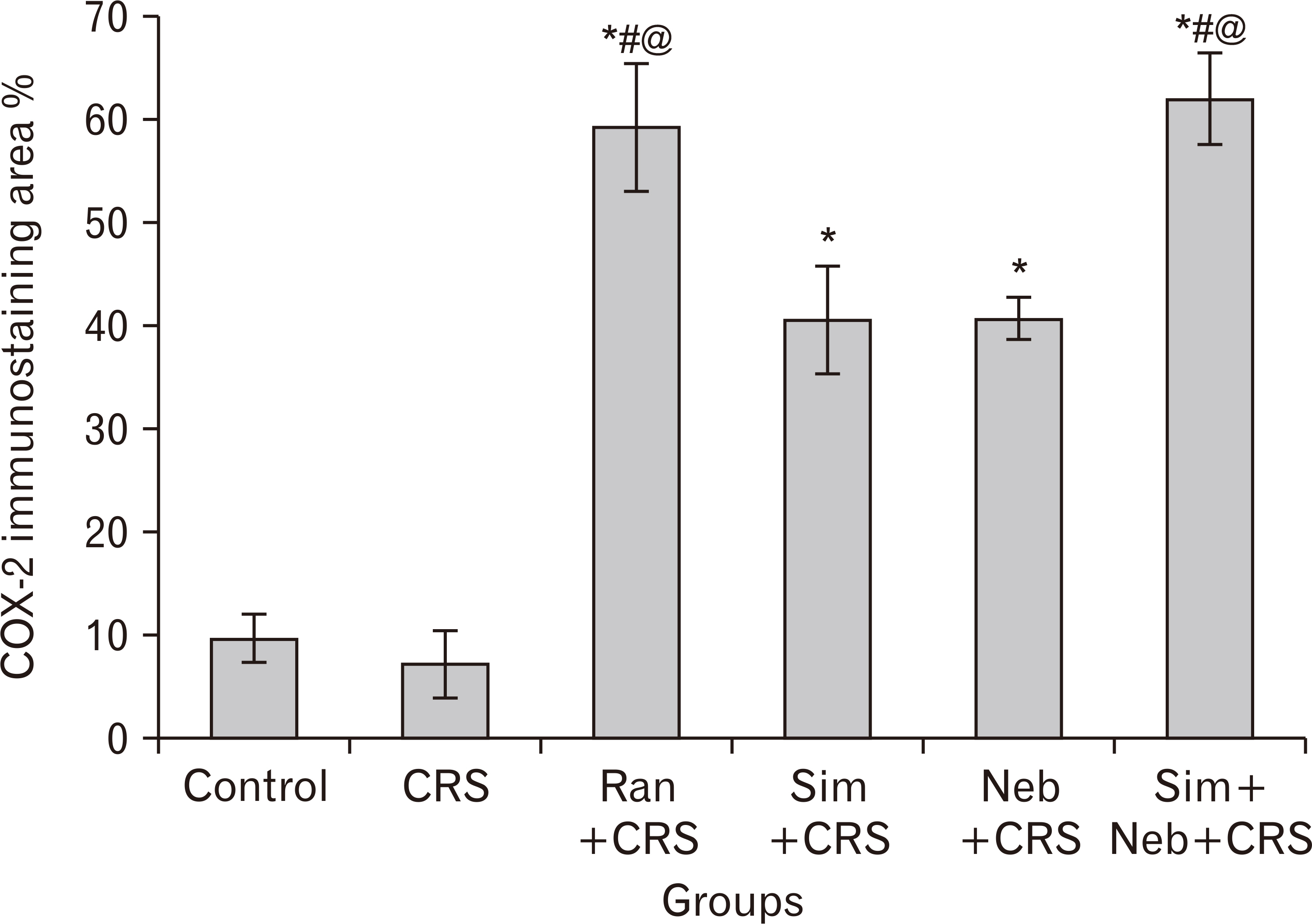Anat Cell Biol.
2020 Sep;53(3):301-312. 10.5115/acb.20.055.
Gastroprotective effects of nebivolol and simvastatin against cold restraint stressinduced gastric ulcer in rats
- Affiliations
-
- 1Department of Histology, Faculty of Medicine, Cairo University, Cairo, Egypt
- 2Department of Medical Pharmacology, Faculty of Medicine, Cairo University, Cairo, Egypt
- 3Department of Basic Medical Sciences, Faculty of Medicine, Hashemite University, Zarqaa, Jordan
- 4Department of Anatomy, Faculty of Medicine, Ain Shams University, Cairo, Egypt
- 5Department of Medical Physiology, Faculty of Medicine, Cairo University, Cairo, Egypt
- KMID: 2507643
- DOI: http://doi.org/10.5115/acb.20.055
Abstract
- Gastric ulcer is one of the most serious diseases. Nebivolol (Neb), a β1-blocker, exhibits vasodilator and antioxidative properties, simvastatin (Sim) antihyperlipidemic drug, exhibits anti-oxidative, anti-inflammatory properties and promote endogenous nitric oxide (NO) production. The aim of this study was to evaluate the gastroprotective effects of Neb and Sim against cold restraint stress (CRS)-induced gastric ulcer in rats. Rats were restrained, and maintained at 4°C for 3 hours. Animals were divided into six groups; control group, CRS group, and four treatment groups received ranitidine (Ran), Neb, Sim and both Neb and Sim. Treatments were given orally on a daily basis for 7 days prior to CRS. The gastroprotective effects of Neb and Sim were assessed biochemically by measuring variations in prostaglandins E2, NO, reduced glutathione and malondialdehyde, and functionally by estimating force of contractions of isolated rat fundus in the studied groups in response to acetylecholine stimulation and morphologically using hematoxylin and eosin staining, periodic acid Schiff ’s reaction and immunohistochemistry for cyclooxygenase 2 in gastric mucosa. CRS caused significant ulcerogenic effect. Alternatively, pretreatment with Ran, Neb, and Sim significantly corrected biochemical findings, pharmacological and histological studies.
Keyword
Figure
Reference
-
References
1. Khazaei M, Salehi H. 2006; Protective effect of falcaria vulgaris extract on ethanol induced gastric ulcer in rat. Iran J Pharmacol Ther. 5:43–6.2. Bayir Y, Odabasoglu F, Cakir A, Aslan A, Suleyman H, Halici M, Kazaz C. 2006; The inhibition of gastric mucosal lesion, oxidative stress and neutrophil-infiltration in rats by the lichen constituent diffractaic acid. Phytomedicine. 13:584–90. DOI: 10.1016/j.phymed.2005.07.002. PMID: 16920514.
Article3. Bonamin F, Moraes TM, Dos Santos RC, Kushima H, Faria FM, Silva MA, Junior IV, Nogueira L, Bauab TM, Souza Brito AR, da Rocha LR, Hiruma-Lima CA. 2014; The effect of a minor constituent of essential oil from Citrus aurantium: the role of β-myrcene in preventing peptic ulcer disease. Chem Biol Interact. 212:11–9. DOI: 10.1016/j.cbi.2014.01.009. PMID: 24480520.
Article4. Lima ZP, Severi JA, Pellizzon CH, Brito AR, Solis PN, Cáceres A, Girón LM, Vilegas W, Hiruma-Lima CA. 2006; Can the aqueous decoction of mango flowers be used as an antiulcer agent? J Ethnopharmacol. 106:29–37. DOI: 10.1016/j.jep.2005.11.032. PMID: 16500058.
Article5. Valle JD. Fauci AS, Harrison TR, editors. 2008. Peptic ulcer disease and related disorders. Harrison's principles of internal medicine. 17th ed. McGraw-Hill;New York: p. 1855–1872.6. Dimaline R, Varro A. 2007; Attack and defence in the gastric epithelium- a delicate balance. Exp Physiol. 92:591–601. DOI: 10.1113/expphysiol.2006.036483. PMID: 17412751.7. Yeomans ND. 2011; The ulcer sleuths: the search for the cause of peptic ulcers. J Gastroenterol Hepatol. 26 Suppl 1:35–41. DOI: 10.1111/j.1440-1746.2010.06537.x. PMID: 21199512.
Article8. Wallace JL, Miller MJ. 2000; Nitric oxide in mucosal defense: a little goes a long way. Gastroenterology. 119:512–20. DOI: 10.1053/gast.2000.9304. PMID: 10930387.
Article9. Ohta Y, Nishida K. 2003; Protective effect of coadministered superoxide dismutase and catalase against stress-induced gastric mucosal lesions. Clin Exp Pharmacol Physiol. 30:545–50. DOI: 10.1046/j.1440-1681.2003.03871.x. PMID: 12890175.10. Aragón JP, Condit ME, Bhushan S, Predmore BL, Patel SS, Grinsfelder DB, Gundewar S, Jha S, Calvert JW, Barouch LA, Lavu M, Wright HM, Lefer DJ. 2011; Beta3-adrenoreceptor stimulation ameliorates myocardial ischemia-reperfusion injury via endothelial nitric oxide synthase and neuronal nitric oxide synthase activation. J Am Coll Cardiol. 58:2683–91. DOI: 10.1016/j.jacc.2011.09.033. PMID: 22152956. PMCID: PMC3586978.
Article11. Sorrentino SA, Doerries C, Manes C, Speer T, Dessy C, Lobysheva I, Mohmand W, Akbar R, Bahlmann F, Besler C, Schaefer A, Hilfiker-Kleiner D, Lüscher TF, Balligand JL, Drexler H, Landmesser U. 2011; Nebivolol exerts beneficial effects on endothelial function, early endothelial progenitor cells, myocardial neovascularization, and left ventricular dysfunction early after myocardial infarction beyond conventional β1-blockade. J Am Coll Cardiol. 57:601–11. DOI: 10.1016/j.jacc.2010.09.037. PMID: 21272752.
Article12. Fonseca VA. 2010; Effects of beta-blockers on glucose and lipid metabolism. Curr Med Res Opin. 26:615–29. DOI: 10.1185/03007990903533681. PMID: 20067434.13. Corsini A, Maggi FM, Catapano AL. 1995; Pharmacology of competitive inhibitors of HMG-CoA reductase. Pharmacol Res. 31:9–27. DOI: 10.1016/1043-6618(95)80042-5.
Article14. Liao JK. 2005; Effects of statins on 3-hydroxy-3-methylglutaryl coenzyme a reductase inhibition beyond low-density lipoprotein cholesterol. Am J Cardiol. 96(5A):24F–33F. DOI: 10.1016/j.amjcard.2005.06.009. PMID: 16126020. PMCID: PMC2684977.
Article15. Trochu JN, Mital S, Zhang Xp, Xu X, Ochoa M, Liao JK, Recchia FA, Hintze TH. 2003; Preservation of NO production by statins in the treatment of heart failure. Cardiovasc Res. 60:250–8. DOI: 10.1016/j.cardiores.2003.08.003. PMID: 14613854. PMCID: PMC2653218.
Article16. Schrör K, Löbel P, Steinhagen-Thiessen E. 1989; Simvastatin reduces platelet thromboxane formation and restores normal platelet sensitivity against prostacyclin in type IIa hypercholesterolemia. Eicosanoids. 2:39–45. PMID: 2483819.17. Ungureanu D, Filip C, Artenie A, Artenie R. 2003; Evaluation of simvastatin antioxidant effects. Rev Med Chir Soc Med Nat Iasi. 107:66–71.18. Institute for Laboratory Animal Research. National Academies Press. 2011. Guide for the care and use of laboratory animals. 8th ed. National Academies Press;Washington: p. 220.19. Dronjak S, Gavrilović L, Filipović D, Radojcić MB. 2004; Immobilization and cold stress affect sympatho-adrenomedullary system and pituitary-adrenocortical axis of rats exposed to long-term isolation and crowding. Physiol Behav. 81:409–15. DOI: 10.1016/j.physbeh.2004.01.011. PMID: 15135012.
Article20. Das D, Banerjee RK. 1993; Effect of stress on the antioxidant enzymes and gastric ulceration. Mol Cell Biochem. 125:115–25. DOI: 10.1007/BF00936440. PMID: 8283967.
Article21. Bahgat AK. 2009; Gastroprotective effect of L-carnitine on indomethacin-induced gastric ulcer in rats: the involvement of antioxidant mechanisms and nitric oxide. Med J Cairo Univ. 77:43–51.22. Abd El Motteleb DM, Hasan MM. 2011; Gastroprotective effect of simvastatin against experimentally induced gastric ulcers in rats: role of ATP-sensitive K+ channels. J Am Sci. 7:760–8.23. Morsy MA, Heeba GH, Abdelwahab SA, Rofaeil RR. 2012; Protective effects of nebivolol against cold restraint stress-induced gastric ulcer in rats: role of NO, HO-1, and COX-1,2. Nitric Oxide. 27:117–22. DOI: 10.1016/j.niox.2012.06.001. PMID: 22687651.
Article24. Vane JR. 1957; A sensitive method for the assay of 5-hydroxytryptamine. Br J Pharmacol Chemother. 12:344–9. DOI: 10.1111/j.1476-5381.1957.tb00146.x. PMID: 13460242.
Article25. Ohkawa H, Ohishi N, Yagi K. 1979; Assay for lipid peroxides in animal tissues by thiobarbituric acid reaction. Anal Biochem. 95:351–8. DOI: 10.1016/0003-2697(79)90738-3. PMID: 36810.
Article26. Ellman GL. 1959; Tissue sulfhydryl groups. Arch Biochem Biophys. 82:70–7. DOI: 10.1016/0003-9861(59)90090-6.
Article27. Habig WH, Pabst MJ, Jakoby WB. 1974; Glutathione S-transferases. The first enzymatic step in mercapturic acid formation. J Biol Chem. 249:7130–9. PMID: 4436300.28. Hamberg M, Samuelsson B. 1973; Detection and isolation of an endoperoxide intermediate in prostaglandin biosynthesis. Proc Natl Acad Sci U S A. 70:899–903. DOI: 10.1073/pnas.70.3.899. PMID: 4514999. PMCID: PMC433384.
Article29. Miranda KM, Espey MG, Wink DA. 2001; A rapid, simple spectrophotometric method for simultaneous detection of nitrate and nitrite. Nitric Oxide. 5:62–71. DOI: 10.1006/niox.2000.0319. PMID: 11178938.
Article30. Zhang H, Li X, Ding J, Xu H, Dai X, Hou Z, Zhang K, Sun K, Sun W. 2013; Delivery of ursolic acid (UA) in polymeric nanoparticles effectively promotes the apoptosis of gastric cancer cells through enhanced inhibition of cyclooxygenase 2 (COX-2). Int J Pharm. 441:261–8. DOI: 10.1016/j.ijpharm.2012.11.034. PMID: 23194884.
Article31. Altman GD. Altman GD, editor. 2005. Three or more independent groups of observations. Practical statistics for medical research. 2nd ed. Chapman & Hall;London: p. 205–17.32. Kwiecień S, Brzozowski T, Konturek SJ. 2002; Effects of reactive oxygen species action on gastric mucosa in various models of mucosal injury. J Physiol Pharmacol. 53:39–50. DOI: 10.1139/apnm-2017-0138. PMID: 11939718.33. Brzozowski T, Konturek PC, Pajdo R, Ptak-Belowska A, Kwiecien S, Pawlik M, Drozdowicz D, Sliwowski Z, Brzozowski B, Konturek SJ, Pawlik WW. 2008; Physiological mediators in nonsteroidal anti-inflammatory drugs (NSAIDs)-induced impairment of gastric mucosal defense and adaptation. Focus on nitric oxide and lipoxins. J Physiol Pharmacol. 59 Suppl 2:89–102. PMID: 18812631.34. Haendeler J, Hoffmann J, Zeiher AM, Dimmeler S. 2004; Antioxidant effects of statins via S-nitrosylation and activation of thioredoxin in endothelial cells: a novel vasculoprotective function of statins. Circulation. 110:856–61. DOI: 10.1161/01.CIR.0000138743.09012.93. PMID: 15289372.35. Tariq M, Khan HA, Elfaki I, Arshaduddin M, Al Moutaery M, Al Rayes H, Al Swailam R. 2007; Gastric antisecretory and antiulcer effects of simvastatin in rats. J Gastroenterol Hepatol. 22:2316–23. DOI: 10.1111/j.1440-1746.2007.05021.x. PMID: 17593225.
Article36. Matsui H, Shimokawa O, Kaneko T, Nagano Y, Rai K, Hyodo I. 2011; The pathophysiology of non-steroidal anti-inflammatory drug (NSAID)-induced mucosal injuries in stomach and small intestine. J Clin Biochem Nutr. 48:107–11. DOI: 10.3164/jcbn.10-79. PMID: 21373261. PMCID: PMC3045681.
Article37. Bjarnason I, Scarpignato C, Takeuchi K, Rainsford KD. 2007; Determinants of the short-term gastric damage caused by NSAIDs in man. Aliment Pharmacol Ther. 26:95–106. DOI: 10.1111/j.1365-2036.2007.03348.x. PMID: 17555426.
Article38. Ma L, Wallace JL. 2000; Endothelial nitric oxide synthase modulates gastric ulcer healing in rats. Am J Physiol Gastrointest Liver Physiol. 279:G341–6. DOI: 10.1152/ajpgi.2000.279.2.G341. PMID: 10915643. PMCID: PMC4950842.
Article39. Kato S, Ohkawa F, Ito Y, Amagase K, Takeuchi K. 2009; Role of endothelial nitric oxide synthase in aggravation of indomethacin-induced gastric damage in adjuvant arthritic rats. J Physiol Pharmacol. 60:147–55. PMID: 20065509.40. Cho CH. 2001; Current roles of nitric oxide in gastrointestinal disorders. J Physiol Paris. 95:253–6. DOI: 10.1016/S0928-4257(01)00034-1.
Article41. Lanas A. 2008; Role of nitric oxide in the gastrointestinal tract. Arthritis Res Ther. 10(Suppl 2):S4. DOI: 10.1186/ar2465. PMID: 19007429.
Article42. Goel R, Goel A, Manocha A, Pillai KK, Srivastava RS. 2009; Influence of nebivolol on anticonvulsant effect of lamotrigine. Indian J Pharmacol. 41:41–6. DOI: 10.4103/0253-7613.48890. PMID: 20177581. PMCID: PMC2825014.
Article43. Ceron CS, Rizzi E, Guimarães DA, Martins-Oliveira A, Gerlach RF, Tanus-Santos JE. 2013; Nebivolol attenuates prooxidant and profibrotic mechanisms involving TGF-β and MMPs, and decreases vascular remodeling in renovascular hypertension. Free Radic Biol Med. 65:47–56. DOI: 10.1016/j.freeradbiomed.2013.06.033. PMID: 23806385.
Article44. Rizzi E, Guimaraes DA, Ceron CS, Prado CM, Pinheiro LC, Martins-Oliveira A, Gerlach RF, Tanus-Santos JE. 2014; β1-Adrenergic blockers exert antioxidant effects, reduce matrix metalloproteinase activity, and improve renovascular hypertension-induced cardiac hypertrophy. Free Radic Biol Med. 73:308–17. DOI: 10.1016/j.freeradbiomed.2014.05.024. PMID: 24933619.
Article45. Dursun S, Çuhadar S, Köseoğlu M, Atay A, Aktaş SG. 2014; The anti-inflammatory and antioxidant effects of pravastatin and nebivolol in rat aorta. Anadolu Kardiyol Derg. 14:229–33. DOI: 10.5152/akd.2013.4708. PMID: 24936540.
Article46. Uzar E, Acar A, Evliyaoğlu O, Fırat U, Kamasak K, Göçmez C, Alp H, Tüfek A, Taşdemir N, Ilhan A. 2012; The anti-oxidant and anti-apoptotic effects of nebivolol and zofenopril in a model of cerebral ischemia/reperfusion in rats. Prog Neuropsychopharmacol Biol Psychiatry. 36:22–8. DOI: 10.1016/j.pnpbp.2011.08.011. PMID: 21888941.
Article47. Whaley-Connell A, Habibi J, Johnson M, Tilmon R, Rehmer N, Rehmer J, Wiedmeyer C, Ferrario CM, Sowers JR. 2009; Nebivolol reduces proteinuria and renal NADPH oxidase-generated reactive oxygen species in the transgenic Ren2 rat. Am J Nephrol. 30:354–60. DOI: 10.1159/000229305. PMID: 19609077. PMCID: PMC2814025.
Article48. Abd Allah OM, Sharaf El-Din AAI. 2016; Nebivolol ameliorates indomethacin-induced gastric ulcer in adult albino rats: role of inducible nitric oxide synthase. Egypt J Forensic Sci Appli Toxicol. 16:147–67. DOI: 10.21608/ejfsat.2016.41023.
Article49. Parenti A, Filippi S, Amerini S, Granger HJ, Fazzini A, Ledda F. 2000; Inositol phosphate metabolism and nitric-oxide synthase activity in endothelial cells are involved in the vasorelaxant activity of nebivolol. J Pharmacol Exp Ther. 292:698–703. PMID: 10640308.50. Kalinowski L, Dobrucki LW, Szczepanska-Konkel M, Jankowski M, Martyniec L, Angielski S, Malinski T. 2003; Third-generation beta-blockers stimulate nitric oxide release from endothelial cells through ATP efflux: a novel mechanism for antihypertensive action. Circulation. 107:2747–52. DOI: 10.1161/01.CIR.0000066912.58385.DE. PMID: 12742996.51. Zhou X, Ma L, Habibi J, Whaley-Connell A, Hayden MR, Tilmon RD, Brown AN, Kim JA, Demarco VG, Sowers JR. 2010; Nebivolol improves diastolic dysfunction and myocardial remodeling through reductions in oxidative stress in the Zucker obese rat. Hypertension. 55:880–8. DOI: 10.1161/HYPERTENSIONAHA.109.145136. PMID: 20176997. PMCID: PMC2841702.
Article52. Manrique C, Lastra G, Habibi J, Pulakat L, Schneider R, Durante W, Tilmon R, Rehmer J, Hayden MR, Ferrario CM, Whaley-Connell A, Sowers JR. 2011; Nebivolol improves insulin sensitivity in the TGR(Ren2)27 rat. Metabolism. 60:1757–66. DOI: 10.1016/j.metabol.2011.04.009. PMID: 21640361. PMCID: PMC3170670.
Article53. Martin GR, Wallace JL. 2006; Gastrointestinal inflammation: a central component of mucosal defense and repair. Exp Biol Med (Maywood). 231:130–7. DOI: 10.1177/153537020623100202. PMID: 16446488.
Article54. Vaseem A, Ali M, Afshan K. 2017; Activity of Tulsi leaves (Ocimum sanctum linn) in protecting gastric ulcer in rats by cold restrain method. Int J Basic Clin Pharmacol. 6:2343–7. DOI: 10.18203/2319-2003.ijbcp20174356.
Article55. Godara R, Katoch R, Yadav A, Ahanger RR, Bhutyal AD, Verma PK, Katoch M, Dutta S, Nisa F, Singh NK. 2015; In vitro acaricidal activity of ethanolic and aqueous floral extracts of Calendula officinalis against synthetic pyrethroid resistant Rhipicephalus (Boophilus) microplus. Exp Appl Acarol. 67:147–57. DOI: 10.1007/s10493-015-9929-9. PMID: 26071101.
Article56. Banfi C, Baetta R, Gianazza E, Tremoli E. 2017; Technological advances and proteomic applications in drug discovery and target deconvolution: identification of the pleiotropic effects of statins. Drug Discov Today. 22:848–69. DOI: 10.1016/j.drudis.2017.03.001. PMID: 28284830.
Article57. Heeba GH, Hassan MK, Amin RS. 2009; Gastroprotective effect of simvastatin against indomethacin-induced gastric ulcer in rats: role of nitric oxide and prostaglandins. Eur J Pharmacol. 607:188–93. DOI: 10.1016/j.ejphar.2009.02.008. PMID: 19217901.
Article58. Liao WC, Huang MZ, Wang ML, Lin CJ, Lu TL, Lo HR, Pan YJ, Sun YC, Kao MC, Lim HJ, Lai CH. 2017; Statin decreases Helicobacter pylori burden in macrophages by promoting autophagy. Front Cell Infect Microbiol. 6:203. DOI: 10.3389/fcimb.2016.00203. PMID: 28144585.
Article59. Lin CJ, Liao WC, Chen YA, Lin HJ, Feng CL, Lin CL, Lin YJ, Kao MC, Huang MZ, Lai CH, Kao CH. 2017; Statin therapy is associated with reduced risk of peptic ulcer disease in the Taiwanese population. Front Pharmacol. 8:210. DOI: 10.3389/fphar.2017.00210. PMID: 28503146. PMCID: PMC5408271.
Article60. Han ME, Oh SO. 2013; Gastric stem cells and gastric cancer stem cells. Anat Cell Biol. 46:8–18. DOI: 10.5115/acb.2013.46.1.8. PMID: 23560232.
Article61. Elwood PC, Gallagher AM, Duthie GG, Mur LA, Morgan G. 2009; Aspirin, salicylates, and cancer. Lancet. 373:1301–9. DOI: 10.1016/S0140-6736(09)60243-9.
Article62. Warzecha Z, Ceranowicz P, Dembinski M, Cieszkowski J, Ginter G, Ptak-Belowska A, Dembinski A. 2014; Involvement of cyclooxygenase-1 and cyclooxygenase-2 activity in the therapeutic effect of ghrelin in the course of ethanol-induced gastric ulcers in rats. J Physiol Pharmacol. 65:95–106. PMID: 24622834.63. El-Ashmawy NE, Khedr EG, El-Bahrawy HA, Selim HM. 2016; Nebivolol prevents indomethacin-induced gastric ulcer in rats. J Immunotoxicol. 13:580–9. DOI: 10.3109/1547691X.2016.1142488. PMID: 27224860.
Article64. Rizos E, Bairaktari E, Kostoula A, Hasiotis G, Achimastos A, Ganotakis E, Elisaf M, Mikhailidis DP. 2003; The combination of nebivolol plus pravastatin is associated with a more beneficial metabolic profile compared to that of atenolol plus pravastatin in hypertensive patients with dyslipidemia: a pilot study. J Cardiovasc Pharmacol Ther. 8:127–34. DOI: 10.1177/107424840300800206. PMID: 12808486.
Article
- Full Text Links
- Actions
-
Cited
- CITED
-
- Close
- Share
- Similar articles
-
- Gastroprotective Activities of Sennoside A and Sennoside B via the Up-Regulation of Prostaglandin E2 and the Inhibition of H+/K+-ATPase
- Gastroprotective Effects of Glutinous Rice Extract against Ethanol-, Indomethacin-, and Stress-induced Ulcers in Rats
- New Rat Model for the Research of Stress Ulcer Accompanying Subarachnoid Hemorrhage
- Assessment of Antisecretory, Gastroprotective, and
In-vitro Antacid Potential ofDaucus carota in Experimental Rats - Gastroprotective Potential of
Dalbergia sissoo Roxb. Stem Bark against Diclofenac-Induced Gastric Damage in Rats








